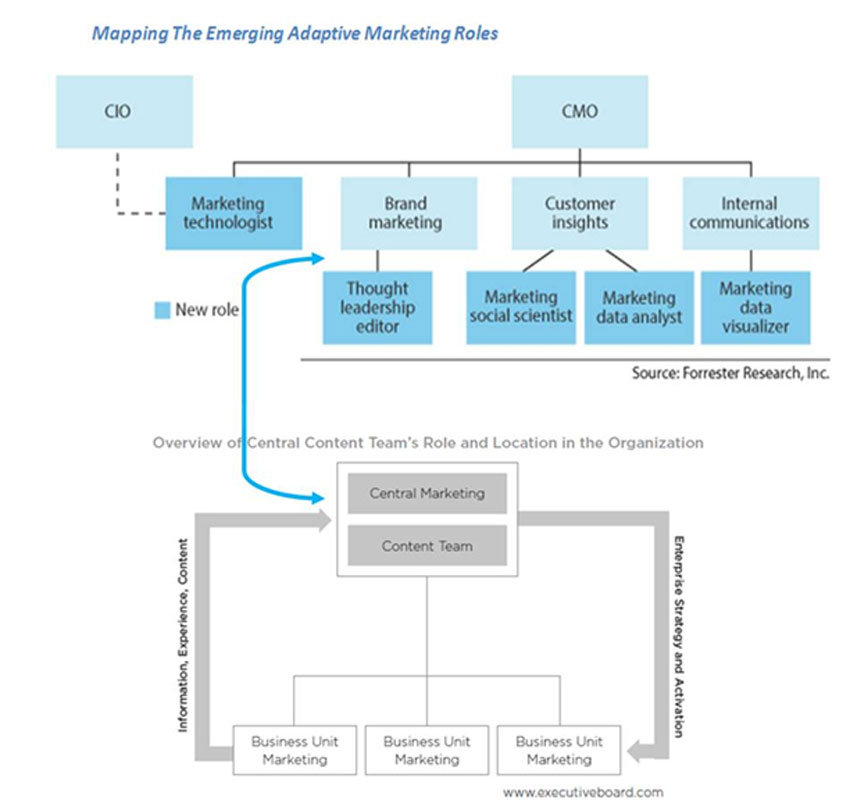An organizational structure defines how activities such as task allocation, coordination and supervision are directed towards the achievement of organizational aims. It can also be considered as the viewing glass or perspective through which individuals see their organization and its environment.
Organizations are a variant of clustered entities.
An organization can be structured in many different ways, depending on their objectives. The structure of an organization will determine the modes in which it operates and performs.
Organizational structure allows the expressed allocation of responsibilities for different functions and processes to different entities such as the branch, department, workgroup and individual.
Organizational structure affects organizational action in two big ways :
- First, it provides the foundation on which standard operating procedures and routines rest.
- Second, it determines which individuals get to participate in which decision-making processes, and thus to what extent their views shape the organization's actions.

History
Organizational structures developed from the ancient times of hunters and collectors in tribal organizations through highly royal and clerical power structures to industrial structures and today's post-industrial structures.
As pointed out by Lawrence B. Mohr, the early theorists of organizational structure, Taylor, Fayol, and Weber "saw the importance of structure for effectiveness and efficiency and assumed without the slightest question that whatever structure was needed, people could fashion accordingly. Organizational structure was considered a matter of choice... When in the 1930s, the rebellion began that came to be known as human relations theory, there was still not a denial of the idea of structure as an artifact, but rather an advocacy of the creation of a different sort of structure, one in which the needs, knowledge, and opinions of employees might be given greater recognition." However, a different view arose in the 1960s, suggesting that the organizational structure is "an externally caused phenomenon, an outcome rather than an artifact."
In the 21st century, organizational theorists such as Lim, Griffiths, and Sambrook (2010) are once again proposing that organizational structure development is very much dependent on the expression of the strategies and behavior of the management and the workers as constrained by the power distribution between them, and influenced by their environment and the outcome.
Marketing Team Structure Video
Operational organizations and informal organizations
The set organizational structure may not coincide with facts, evolving in operational action. Such divergence decreases performance, when growing. E.g., a wrong organizational structure may hamper cooperation and thus hinder the completion of orders in due time and within limits of resources and budgets. Organizational structures shall be adaptive to process requirements, aiming to optimize the ratio of effort and input to output.

Types
Pre-bureaucratic structures
Pre-bureaucratic (entrepreneurial) structures lack standardization of tasks. This structure is most common in smaller organizations and is best used to solve simple tasks. The structure is totally centralized. The strategic leader makes all key decisions and most communication is done by one on one conversations. It is particularly useful for new (entrepreneurial) business as it enables the founder to control growth and development.
They are usually based on traditional domination or charismatic domination in the sense of Max Weber's tripartite classification of authority.
Bureaucratic structures
Weber (1948, p. 214) gives the analogy that "the fully developed bureaucratic mechanism compares with other organizations exactly as does the machine compare with the non-mechanical modes of production. Precision, speed, unambiguity, ... strict subordination, reduction of friction and of material and personal costs- these are raised to the optimum point in the strictly bureaucratic administration." Bureaucratic structures have a certain degree of standardization. They are better suited for more complex or larger scale organizations, usually adopting a tall structure. The tension between bureaucratic structures and non-bureaucratic is echoed in Burns and Stalker's distinction between mechanistic and organic structures.
The Weberian characteristics of bureaucracy are:
- Clear defined roles and responsibilities
- A hierarchical structure
- Respect for merit
Bureaucratic structures have many levels of management ranging from senior executives to regional managers, all the way to department store managers. Since there are many levels, decision-making authority has to pass through more layers than flatter organizations. Bureaucratic organization has rigid and tight procedures, policies and constraints. These kind of structure is reluctant to adapt or change what they have been doing since the company started. Organizational charts exist for every department, and everyone understands who is in charge and what their responsibilities are for every situation. Decisions are made through an organized process, and a strict command and control structure is present at all times.In bureaucratic structures, the authority is at the top and information is then flowed from top to bottom. This causes for more rules and standards for the company which operational process is watched with close supervision. Some advantages for bureaucratic structures for top-level managers are they have a tremendous control over organizational structure decisions. This works best for managers who have a command and control style of managing. Strategic decision-making is also faster because there are fewer people it has to go through to approve. Some disadvantages in bureaucratic structures are it can discourage creativity and innovation in the organization. This can make it hard for a company to adapt to changing conditions in the marketplace.
Post-bureaucratic
The term of post bureaucratic is used in two senses in the organizational literature: one generic and one much more specific. In the generic sense the term post bureaucratic is often used to describe a range of ideas developed since the 1980s that specifically contrast themselves with Weber's ideal type bureaucracy. This may include total quality management, culture management and matrix management, amongst others. None of these however has left behind the core tenets of Bureaucracy. Hierarchies still exist, authority is still Weber's rational, legal type, and the organization is still rule bound. Heckscher, arguing along these lines, describes them as cleaned up bureaucracies, rather than a fundamental shift away from bureaucracy. Gideon Kunda, in his classic study of culture management at 'Tech' argued that 'the essence of bureaucratic control - the formalisation, codification and enforcement of rules and regulations - does not change in principle.....it shifts focus from organizational structure to the organization's culture'.
Another smaller group of theorists have developed the theory of the Post-Bureaucratic Organization., provide a detailed discussion which attempts to describe an organization that is fundamentally not bureaucratic. Charles Heckscher has developed an ideal type, the post-bureaucratic organization, in which decisions are based on dialogue and consensus rather than authority and command, the organization is a network rather than a hierarchy, open at the boundaries (in direct contrast to culture management); there is an emphasis on meta-decision-making rules rather than decision-making rules. This sort of horizontal decision-making by consensus model is often used in housing cooperatives, other cooperatives and when running a non-profit or community organization. It is used in order to encourage participation and help to empower people who normally experience oppression in groups.
Still other theorists are developing a resurgence of interest in complexity theory and organizations, and have focused on how simple structures can be used to engender organizational adaptations. For instance, Miner et al. (2000) studied how simple structures could be used to generate improvisational outcomes in product development. Their study makes links to simple structures and improviser learning. Other scholars such as Jan Rivkin and Sigglekow, and Nelson Repenning revive an older interest in how structure and strategy relate in dynamic environments.
Functional structure
A functional organizational structure is a structure that consists of activities such as coordination, supervision and task allocation. The organizational structure determines how the organization performs or operates. The term organizational structure refers to how the people in an organization are grouped and to whom they report. One traditional way of organizing people is by function. Some common functions within an organization include production, marketing, human resources, and accounting.
This organizing of specialization leads to operational efficiency where employees become specialists within their own realm of expertise. The most typical problem with a functional organizational structure is however that communication within the company can be rather rigid, making the organization slow and inflexible. Therefore, lateral communication between functions become very important, so that information is disseminated, not only vertically, but also horizontally within the organization. Communication in organizations with functional organizational structures can be rigid because of the standardized ways of operation and the high degree of formalization.
As a whole, a functional organization is best suited as a producer of standardized goods and services at large volume and low cost. Coordination and specialization of tasks are centralized in a functional structure, which makes producing a limited amount of products or services efficient and predictable. Moreover, efficiencies can further be realized as functional organizations integrate their activities vertically so that products are sold and distributed quickly and at low cost. For instance, a small business could make components used in production of its products instead of buying them.
Even though functional units often perform with a high level of efficiency, their level of cooperation with each other is sometimes compromised. Such groups may have difficulty working well with each other as they may be territorial and unwilling to cooperate. The occurrence of infighting among units may cause delays, reduced commitment due to competing interests, and wasted time, making projects fall behind schedule. This ultimately can bring down production levels overall, and the company-wide employee commitment toward meeting organizational goals.
Divisional structure
The divisional structure or product structure consists of self-contained divisions. A division is a collection of functions which produce a product. It also utilizes a plan to compete and operate as a separate business or profit center. According to Zainbooks.com, divisional structure in America is seen as the second most common structure for organization today.
Employees who are responsible for certain market services or types of products are placed in divisional structure in order to increase their flexibility. Examples of divisions include regional (a U.S Division and an EU division), consumer type (a division for companies and one for households), and product type (a division for trucks, another for SUVS, and another for cars). The divisions may also have their own departments such as marketing, sales, and engineering.
The advantage of divisional structure is that it uses delegated authority so the performance can be directly measured with each group. This results in managers performing better and high employee morale. Another advantage of using divisional structure is that it is more efficient in coordinating work between different divisions, and there is more flexibility to respond when there is a change in the market. Also, a company will have a simpler process if they need to change the size of the business by either adding or removing divisions. When divisional structure is utilized more specialization can occur within the groups. When divisional structure is organized by product, the customer has their own advantages especially when only a few services or products are offered which differ greatly. When using divisional structures that are organized by either markets or geographic areas they generally have similar function and are located in different regions or markets. This allows business decisions and activities coordinated locally.
The disadvantages of the divisional structure is that it can support unhealthy rivalries among divisions. This type of structure may increase costs by requiring more qualified managers for each division. Also, there is usually an over-emphasis on divisional more than organizational goals which results in duplication of resources and efforts like staff services, facilities, and personnel.
Matrix structure
The matrix structure groups employees by both function and product. This structure can combine the best of both separate structures. A matrix organization frequently uses teams of employees to accomplish work, in order to take advantage of the strengths, as well as make up for the weaknesses, of functional and decentralized forms. An example would be a company that produces two products, "product a" and "product b". Using the matrix structure, this company would organize functions within the company as follows: "product a" sales department, "product a" customer service department, "product a" accounting, "product b" sales department, "product b" customer service department, "product b" accounting department.
- Weak/Functional Matrix: A project manager with only limited authority is assigned to oversee the cross- functional aspects of the project. The functional managers maintain control over their resources and project areas.
- Balanced/Functional Matrix: A project manager is assigned to oversee the project. Power is shared equally between the project manager and the functional managers. It brings the best aspects of functional and projectized organizations. However, this is the most difficult system to maintain as the sharing of power is a delicate proposition.
- Strong/Project Matrix: A project manager is primarily responsible for the project. Functional managers provide technical expertise and assign resources as needed.
Matrix structure is only one of the three major structures. The other two are Functional and Project structure. Matrix management is more dynamic than functional management in that it is a combination of all the other structures and allows team members to share information more readily across task boundaries. It also allows for specialization that can increase depth of knowledge in a specific sector or segment.
There are both advantages and disadvantages of the matrix structure; some of the disadvantages are an increase in the complexity of the chain of command. This occurs because of the differentiation between functional managers and project managers, which can be confusing for employees to understand who is next in the chain of command. An additional disadvantage of the matrix structure is higher manager to worker ratio that results in conflicting loyalties of employees. However the matrix structure also has significant advantages that make it valuable for companies to use. The matrix structure improves upon the "silo" critique of functional management in that it diminishes the vertical structure of functional and creates a more horizontal structure which allows the spread of information across task boundaries to happen much quicker. Moreover, matrix structure allows for specialization that can increase depth of knowledge & allows individuals to be chosen according to project needs. This correlation between individuals and project needs is what produces the concept of maximizing strengths and minimizing weaknesses.
Organizational circle: moving back to flat
The flat structure is common in small companies (entrepreneurial start-ups, university spin offs). As companies grow they tend to become more complex and hierarchical, which leads to an expanded structure, with more levels and departments.
However, in rare cases, such as the examples of Valve Corporation, GitHub, Inc. and 37signals, the organization remains very flat as it grows, eschewing middle managers. All of the aforementioned organizations operate in the field of technology, which may be significant, as software developers are highly skilled professionals, much like lawyers. Senior lawyers also enjoy a relatively high degree of autonomy within a typical law firm, which is typically structured as a partnership rather than a hierarchical bureaucracy. Some other types of professional organisations are also commonly structured as partnerships, such as accountancy companies and GP surgeries.
Often, growth would result in bureaucracy, the most prevalent structure in the past. It is still, however, relevant in former Soviet Republics, China, and most governmental organizations all over the world. Shell Group used to represent the typical bureaucracy: top-heavy and hierarchical. It featured multiple levels of command and duplicate service companies existing in different regions. All this made Shell apprehensive to market changes, leading to its incapacity to grow and develop further. The failure of this structure became the main reason for the company restructuring into a matrix.
Starbucks is one of the numerous large organizations that successfully developed the matrix structure supporting their focused strategy. Its design combines functional and product based divisions, with employees reporting to two heads. Creating a team spirit, the company empowers employees to make their own decisions and trains them to develop both hard and soft skills.
Some experts also mention the multinational design, common in global companies, such as Procter & Gamble, Toyota and Unilever. This structure can be seen as a complex form of the matrix, as it maintains coordination among products, functions and geographic areas.
With the growth of the internet, and the associated access that gives all levels of an organization to information and communication via digital means, power structures have begun to align more as a wirearchy, enabling the flow of power and authority to be based not on hierarchical levels, but on information, trust, credibility, and a focus on results.
In general, over the last decade, it has become increasingly clear that through the forces of globalization, competition and more demanding customers, the structure of many companies has become flatter, less hierarchical, more fluid and even virtual.
Team
One of the newest organizational structures developed in the 20th century is team and the related concept of team development or team building. In small businesses, the team structure can define the entire organization. Teams can be both horizontal and vertical. While an organization is constituted as a set of people who synergize individual competencies to achieve newer dimensions, the quality of organizational structure revolves around the competencies of teams in totality. For example, every one of the Whole Foods Market stores, the largest natural-foods grocer in the US developing a focused strategy, is an autonomous profit centre composed of an average of 10 self-managed teams, while team leaders in each store and each region are also a team. Larger bureaucratic organizations can benefit from the flexibility of teams as well. Xerox, Motorola, and DaimlerChrysler are all among the companies that actively use teams to perform tasks.
Network
Another modern structure is network. While business giants risk becoming too clumsy to proact (such as), act and react efficiently, the new network organizations contract out any business function, that can be done better or more cheaply. In essence, managers in network structures spend most of their time coordinating and controlling external relations, usually by electronic means. H&M is outsourcing its clothing to a network of 700 suppliers, more than two-thirds of which are based in low-cost Asian countries. Not owning any factories, H&M can be more flexible than many other retailers in lowering its costs, which aligns with its low-cost strategy. The potential management opportunities offered by recent advances in complex networks theory have been demonstrated including applications to product design and development, and innovation problem in markets and industries.
Virtual
Virtual organization is defined as being closely coupled upstream with its suppliers and downstream with its customers such that where one begins and the other ends means little to those who manage the business processes within the entire organization. A special form of boundaryless organization is virtual. Hedberg, Dahlgren, Hansson, and Olve (1999) consider the virtual organization as not physically existing as such, but enabled by software to exist. The virtual organization exists within a network of alliances, using the Internet. This means while the core of the organization can be small but still the company can operate globally be a market leader in its niche. According to Anderson, because of the unlimited shelf space of the Web, the cost of reaching niche goods is falling dramatically. Although none sell in huge numbers, there are so many niche products that collectively they make a significant profit, and that is what made highly innovative Amazon.com so successful.
Hierarchy-Community Phenotype Model of Organizational Structure
In the 21st century, even though most, if not all, organizations are not of a pure hierarchical structure, many managers are still blind to the existence of the flat community structure within their organizations.
The business is no longer just a place where people come to work. For most of the employees, the firm confers on them that sense of belonging and identity -- the firm has become their "village", their community. The firm of the 21st century is not just a hierarchy which ensures maximum efficiency and profit; it is also the community where people belong to and grow together, where their affective and innovative needs are met.
Lim, Griffiths, and Sambrook (2010) developed the Hierarchy-Community Phenotype Model of Organizational Structure borrowing from the concept of Phenotype from genetics. "A phenotype refers to the observable characteristics of an organism. It results from the expression of an organism's genes and the influence of the environment. The expression of an organism's genes is usually determined by pairs of alleles. Alleles are different forms of a gene. In our model, each employee's formal, hierarchical participation and informal, community participation within the organization, as influenced by his or her environment, contributes to the overall observable characteristics (phenotype) of the organization. In other words, just as all the pair of alleles within the genetic material of an organism determines the physical characteristics of the organism, the combined expressions of all the employees' formal hierarchical and informal community participation within an organization give rise to the organizational structure. Due to the vast potentially different combination of the employees' formal hierarchical and informal community participation, each organization is therefore a unique phenotype along a spectrum between a pure hierarchy and a pure community (flat) organizational structure."

Bibliography
- Lawrence B. Mohr, Explaining Organizational Behavior. The Limits and Possibilities of Theory and Research., Jossey-Bass Publishers, 1982.
Are You Looking for Products
Here some products related to "Organizational Structure".
Hair Salon Marketing Recr..
Persuading Scientists: Ma..
Global Cause Marketing: F..
As We Speak: How to Make ..
Get these at Amazon.com* amzn.to is official short URL for Amazon.com, provided by Bitly
Source of the article : here






EmoticonEmoticon